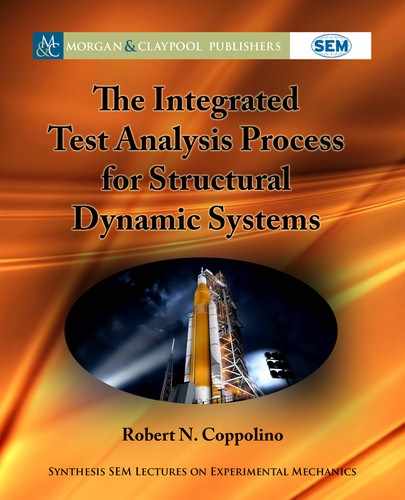4.2. PART2: FREQUENCYRESPONSE FUNCTION ESTIMATES FROM MEASUREDDATA 75
A second strategy for screening of measured data records includes review of swept sine
excitation induced spectrograms for all excitation and response records. e occurrence of har-
monic distortion (frequency content other than the excitation frequency) provides an indication
of nonlinear dynamic behavior. Moreover, in the case of localized nonlinear behavior, proximity
of response channels to a nonlinear mechanism is indicated by severity of harmonic distortion.
Application of this strategy was quite effective in localization of nonlinear behavior during ISS
P5 modal testing. In addition, focused response spectrum analyses during time segments indict-
ing strongest nonlinear activity provided confirming data related to nonlinear behavior.
4.2 PART 2: FREQUENCY RESPONSE FUNCTION
ESTIMATES FROM MEASURED DATA
4.2.1 INTRODUCTION
e response characteristics of linear dynamic systems, namely frequency response functions
(FRFs) are theoretically expressed in the frequency domain based on response to simple har-
monic excitation. FRFs are estimated employing spectral analysis techniques [1] of measured
excitation and response time history records. Quality of the measured FRF estimates is judged
on the basis of coherence functions that are indicative of “signal to noise” ratios as functions of
frequency.
Well-developed spectral analysis techniques were adapted in the mid-1990s [2] to ad-
dress estimation and identification of dynamic systems exhibiting “algebraic” nonlinear behav-
ior. Treatment of systems exhibiting “hyseteretic” nonlinear behavior, however generally require
employment of specialized time-domain strategies.
After completion of preliminary data evaluations, detailed analyses are often performed
to estimate input-output characteristics of a subject dynamic system. e following sections
provide an overview of single input/single output (SI/SO) and multiple input/single output
(MI/SO) data analysis procedures. Spectral and correlation analysis of SI/SO and MI/SO data
records is the primary tool used for estimation of system FRF characteristics.
4.2.2 MI/MO FREQUENCY RESPONSE EQUATIONS FOR SYSTEMS
WITH ALGEBRAIC NONLINEARITIES
Consider the time domain matrix equation set (introduced in Chapter 3), which includes non-
linear force terms, F
N
.t/,
Œ
M
˚
R
U .t /
C
Œ
B
˚
P
U .t /
C
Œ
K
f
U.t/
g
D
Œ
e
f
F
e
.t/
g
C
Œ
N
f
F
N
.t/
g
: (4.16)
e companion Fourier transform of the above equation set is expressed as
..................Content has been hidden....................
You can't read the all page of ebook, please click here login for view all page.
